Madge Kennedy
Madge Kennedy (April 19, 1891 – June 9, 1987) was a stage, film and TV actress whose career began as a stage actress in 1912 and flourished in motion pictures during the silent film era. In 1921, journalist Heywood Broun described her as "the best farce actress in New York".[1]
Madge Kennedy | |
|---|---|
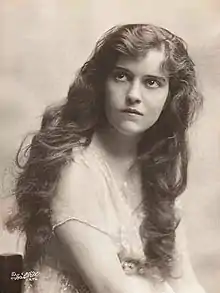 Kennedy, ca. 1916 | |
| Born | April 19, 1891 Chicago, Illinois, U.S. |
| Died | June 9, 1987 (aged 96) |
| Occupation | Actress |
| Years active | 1912–1976 |
| Spouse(s) | Harold Bolster
(m. 1918; died 1927)William B. Hanley Jr.
(m. 1939; died 1959) |
Early years
Kennedy was born in Chicago.[2] Her father was a judge in a criminal court.[3] After she and her family lived in California,[2] she moved to New York City with her mother to paint. She studied two years at the Art Students League, planning to be an illustrator.[4] Luis Mora saw her art work and recommended that she go to Siasconset (in Nantucket, Massachusetts) for a summer.
Career
Theater
The Siasconset colony was evenly divided among actors and artists, and painters often gave theatrical performances.
Kennedy appeared in a skit written by Kenneth and Roy Webb[5] and impressed professional Harry Woodruff, who commented, "She could act rings around anybody." As a result, she was offered the lead opposite Woodruff in The Genius.[6] Soon she was in Cleveland, Ohio, where Robert McLaughlin gave her work with his stock company.[5]
Kennedy first appeared on Broadway in Little Miss Brown (1912),[7] a farce in three acts presented at the 48th Street Theater. Critics found Kennedy's performance most pleasing, writing, "Miss Kennedy's youth, good looks, and marked sense of fun helped her to make a decidedly favorable impression last night." That same year she appeared in The Point of View.[7]
1914 saw her in the popular Twin Beds,[7] and in 1915 she scored a sensational hit at the Eltinge Theater as Blanny Wheeler opposite John Cumberland in Avery Hopwood's classic farce, Fair and Warmer,[7] which ran 377 performances. Critic Louis Vincent DeFoe wrote, "Madge Kennedy proves anew that consummate art is involved even in farcical acting." In the late Teens she would leave the stage for three years to appear in moving pictures for Samuel Goldwyn (see "Films" below).
Kennedy returned to the New York stage in November 1920, playing in Cornered,[7] staged at the Astor Theatre. Produced by Henry Savage, the play, taken from the writing of Dodson Mitchell, offered Kennedy a dual role.
In 1923 she starred opposite W.C. Fields in Poppy, where she enjoyed top billing. In the comedy, Beware of Widows (1925),[7] which was produced at Maxine Elliott Theatre, a reviewer for The New York Times noted, once again, Kennedy's physical beauty as well as her skill as a comedian.
Later, she starred in Philip Barry's Paris Bound (1927) and in Noël Coward's Private Lives (1931),[7] having succeeded Gertrude Lawrence.[2]
After an absence of 33 years, she returned to Broadway in August 1965, appearing with her good friend Ruth Gordon in Gordon and Kanin's A Very Rich Woman.[7]
Films
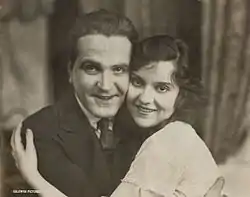
In 1917, Sam Goldwyn of Goldwyn Pictures signed Kennedy to a film contract. She starred in 21 five-reel films,[2] such as Baby Mine (1917), Nearly Married (1917), Our Little Wife (1918), The Service Star (1918) and Dollars and Sense (1920).
Kennedy told a reporter in 1916, "I have discovered that one of the best ways to act is to make your mind as vacant as possible." In 1918, Our Little Wife premiered with Kennedy playing the role of Dodo Warren. The story is about a woman whose marriage is both humorous and sad. The screenplay was adapted from a comedy by Avery Hopwood.
A Perfect Lady (1918) was released in December and was taken from a stage play by Channing Pollock and Rennold Wolf. Kennedy co-starred with James Montgomery. In 1923, she starred in The Purple Highway. The screenplay is an adaptation of the stage play Dear Me, written by Luther Reed and Hale Hamilton.
The 1920s were a productive period for Kennedy. Following The Purple Highway, she had prominent roles in Three Miles Out (1924), Scandal Sheet (1925), Bad Company (1925), Lying Wives (1925), Oh, Baby! (1926), and Walls Tell Tales (1928).
She was out of motion pictures until she resumed her career in The Marrying Kind (1952)[2] and Main Street to Broadway (1953).
In the late 1950s, she combined TV work with roles in movies like The Rains of Ranchipur (1955), The Catered Affair (1956), Lust for Life (1956),[2] Houseboat (1958), A Nice Little Bank That Should Be Robbed (1958), Plunderers of Painted Flats (1959), and North by Northwest (1959).[2] She has an uncredited part as a secretary in the Marilyn Monroe film Let's Make Love (1960).
Her film career endured into the 1970s with roles in They Shoot Horses, Don't They? (1969), The Baby Maker (1970), The Day of the Locust (1975), and Marathon Man (1976).[2]
Radio and television
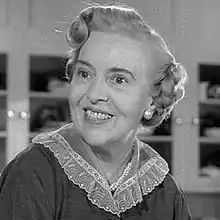
As a guest on the Red Davis series (1934) over NBC Radio and WJZ (WABC-AM) network, Kennedy worked with Burgess Meredith who had the title role. She was written into the full script by the program's creator, Elaine Sterne Carrington.
Kennedy was prolific in terms of her television appearances beginning with an episode of the Schlitz Playhouse of Stars (1954). Her additional performances in television series are Studio 57 (1954), General Electric Theater (1954), Science Fiction Theater (1955), The Life and Legend of Wyatt Earp (1960), The Best of the Post (1961), Alfred Hitchcock Presents (1956–1961), The Alfred Hitchcock Hour (1962), The Twilight Zone (1963), and CBS Playhouse (1967). She also had a semi-recurring role as Theodore Cleaver's Aunt Martha on the hit family sitcom Leave it to Beaver (1957–63). She played June Cleaver's aunt and the Beaver's great-aunt. Ms. Kennedy also appeared as Mimi (the wife of Albert, Felix's grandfather played by Tony Randall) in The Odd Couple (1972).
Producing
Kennedy and her husband, Harold Bolster (who had been an executive with Goldwyn), formed Kenma Corporation, a film production company. Kenma made The Purple Highway (1923) and Three Miles Out (1924), both of which starred Kennedy but had little success.[2]
Personal life and death
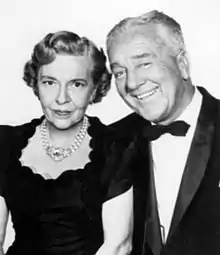
Kennedy's contract with Goldwyn ended in 1921.[2] She decided to return to the stage so that she could be close to her husband, broker Harold Bolster, in New York. Bolster died on August 3, 1927 from an illness he contracted months before during a business trip to South America. He was a member of the New York banking firm of Bennett, Bolster & Coghill. Bolster was 38 and a veteran of World War I. Kennedy inherited more than $500,000 when he died.
She wed William B. Hanley Jr., in Kingman, Arizona, on August 13, 1934. Hanley was an actor and radio personality. The couple resided in Los Angeles, California. Kennedy retired temporarily after her marriage before returning to work in entertainment. The couple would remain married until Hanley's death in 1959.
She enjoyed outdoor activities such as playing golf, horseback riding and driving cars. She owned a Willys-Knight Great Six which she drove avidly at the time she was touring in 1929 in the play, Lulu. In August 1929, she was sued in a Norwich, Connecticut court for damages she caused in a car accident on the Boston Post Road near Groton, Connecticut, in June 1928. The plaintiffs asked for $13,000.[8]
Madge Kennedy died of respiratory failure[9] at the Motion Picture & Television Country House and Hospital[2] in Woodland Hills, California, in 1987. She was 96.
Recognition
Kennedy has a star at 1600 Vine Street in the Motion Pictures section of the Hollywood Walk of Fame. It was dedicated on February 8, 1960.[10]
Selected filmography
Silent

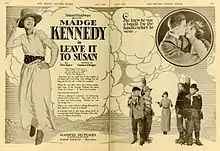
| Year | Title | Role | Notes |
|---|---|---|---|
| 1917 | Baby Mine | Zoie | |
| Nearly Married | Betty Griffon | ||
| 1918 | Our Little Wife | Dodo Warren | |
| The Danger Game | Clytie Rogers | Extant; Instituto Valenciano de Cinematografia (Valencia) | |
| The Fair Pretender | Sylvia Maynard | Extant; Instituto Valenciano de Cinematografia (Valencia) | |
| The Service Star | Marilyn March | ||
| Friend Husband | Dorothy Dean | ||
| Stake Uncle Sam to Play Your Hand | Short | ||
| The Kingdom of Youth | Ruth Betts | ||
| A Perfect Lady | Lucille Le Jambon, aka Lucy Higgins | Extant: George Eastman, 1 reel Lucille Le Jambon, aka Lucy Higgins | |
| 1919 | Day Dreams | Primrose | |
| Daughter of Mine | Rosie Mendelsohn / Lady Diantha | ||
| Leave It to Susan | Susan Burbridge | ||
| Through the Wrong Door | Isabel Carter | ||
| Strictly Confidential | Fanny O'Gorman | Library of Congress; reel 2 | |
| 1920 | The Blooming Angel | Floss | |
| Dollars and Sense | Hazel Farron | Extant; Library of Congress | |
| The Truth | Becky Warder | ||
| Help Yourself | Emily Ray | ||
| 1921 | The Highest Bidder | Sally Raeburn | |
| The Girl with the Jazz Heart | Kittie Swasher / Miriam Smith | ||
| Oh Mary Be Careful | Mary Meacham | Extant Library of Congress | |
| 1923 | The Purple Highway | April Blair | |
| 1924 | Three Miles Out | Molly Townsend | Extant; Gosfilmofond |
| 1925 | Scandal Street | Sheila Kane | |
| Bad Company | Gloria Waring | ||
| Lying Wives | Margery Burkley | George Eastman House; reel 4 | |
| 1926 | Oh, Baby! | Dorothy Brennan | |
| 1928 | Walls Tell Tales | Short |
Talkies
| Year | Title | Role | Notes |
|---|---|---|---|
| 1952 | The Marrying Kind | Judge Anne B. Carroll | |
| 1953 | Main Street to Broadway | Mrs. Cope in Fantasy Sequence | |
| 1955 | The Rains of Ranchipur | Mrs. Smiley | |
| 1956 | Three Bad Sisters | Martha Craig | |
| The Catered Affair | Mrs. Joe Halloran | ||
| Lust for Life | Anna Cornelia Van Gogh | ||
| 1958 | Houseboat | Mrs. Farnsworth | |
| A Nice Little Bank That Should Be Robbed | Grace Havens | ||
| 1959 | Plunderers of Painted Flats | Mary East | |
| North by Northwest | Mrs. Finlay, US Intelligence Agency official | Uncredited | |
| 1960 | Let's Make Love | Miss Manners, Clement's Secretary | Uncredited |
| 1969 | They Shoot Horses, Don't They? | Mrs. Laydon | |
| 1970 | The Baby Maker | Tish's Grandmother | |
| 1975 | The Day of the Locust | Mrs. Johnson | |
| 1976 | Marathon Man | Lady in Bank | final film role |
Television
| Year | Title | Role | Notes |
|---|---|---|---|
| 1954 | Lux Video Theatre | Ma Glover | Episode: "Borrowed Life" |
| Schlitz Playhouse of Stars | Clara Matheson | Episode: "The Secret" | |
| The Lineup | Victim's Mother | Episode: "Cop Killer" | |
| Studio 57 | Grandmother | Episode: "Christmas Every Day" | |
| 1955 | General Electric Theater | Henrietta Mallory | Episode: " Star in the House" |
| Climax! | N/A | Episode: "The Dark Fleece" | |
| Science Fiction Theatre | Mrs. Canby | Episode: "The Unexplored " | |
| 1956 | The Ford Television Theatre | Helen Quade | Episode: " Sometimes It Happens " |
| 1957-63 | Leave It to Beaver | Aunt Martha Bronson | 5 episodes |
| 1958 | Official Detective | Miss Greenville | Episode: "Murder In A Girls School" |
| 1959 | Goodyear Theatre | Birdie | Episode: "I Remember Caviar " |
| 1960 | The Life and Legend of Wyatt Earp | Mary Rowland | Episode: "Don't Get Tough with a Sailor " |
| 1961 | The Best of the Post | Mrs. Bedenbaugh | Episode: "Carnival of Fear " |
| 1967 | CBS Playhouse | Mrs. Flagler | Episode: "Do Not Go Gentle Into That Good Night" |
| 1968 | Julia | Lady Employer | Episode: " Homework Isn't Housework " |
| 1972 | The Odd Couple | Mimi | Episode: "Where's Grandpa?" |
References
- Broun, Heywood (January 8, 1921). "The Play of the Week". Collier's. pp. 15, 23. Retrieved 24 June 2018.
- Slide, Anthony (2010). Silent Players: A Biographical and Autobiographical Study of 100 Silent Film Actors and Actresses. University Press of Kentucky. pp. 193–197. ISBN 978-0813137452. Retrieved 24 June 2018.
- "Musical and Dramatic Review of Week". The Winnipeg Tribune. Canada, Winnipeg, Manitoba. December 31, 1910. p. 12. Retrieved June 24, 2018 – via Newspapers.com.

- "Actress by Accident". The Philadelphia Inquirer. Pennsylvania, Philadelphia. December 29, 1912. p. 29. Retrieved June 24, 2018 – via Newspapers.com.

- "Discovering Madge Kennedy". Cosmopolitan. LVIII (1): 200–201. December 1914. Retrieved 24 June 2018.
- Lowrey, Carolyn (1920). The First One Hundred Noted Men and Women of the Screen. Moffat, Yard. p. 94. Retrieved 24 June 2018.
Madge Kennedy.
- "Madge Kennedy". Internet Broadway Database. The Broadway League. Archived from the original on 24 June 2018. Retrieved 24 June 2018.
- "Madge Kennedy Is Sued $13,000". San Mateo Times, 31 August 1929, p. 8.
- "Madge Kennedy Dies; A Film and Stage Star". The New York Times. 1987. Archived from the original on 30 January 2013. Retrieved 24 June 2018.
- "Madge Kennedy". Hollywood Walk of Fame. Archived from the original on 24 June 2018. Retrieved 24 June 2018.
- "What Los Angeles Is Doing To Love". Atlanta Constitution. August 7, 1921. p. 49.
- "Actress Uses Tonneau Of Car As Dressing Room". Fresno Bee. October 16, 1929. p. 13.
- "Usual Variety Of Pictures On View". Los Angeles Times. July 22, 1923. p. III27.
- "Mate Dies As She Speeds Toward Him". Los Angeles Times. August 4, 1927. p. A1.
- "Altar Trip Of Actress Disclosed". Los Angeles Times. August 27, 1934. p. 1.
- "Hedda Hopper; Madge Kennedy on Stage Again". Los Angeles Times. August 18, 1965. p. D12.
- "Madge Kennedy Is Guest Star". Lowell Sun. October 3, 1934. p. 83.
- "Much That Is Funny In This New Farce". New York Times. August 30, 1912. p. 9.
- "The Story Of Madge Kennedy". New York Times. February 6, 1916. p. X6.
- "Written On The Screen". New York Times. February 10, 1918. p. 51.
- "Written On The Screen". New York Times. December 1, 1918. p. 76.
- "The Play". New York Times. December 2, 1925. p. 22.
- "Madge Kennedy to Play Here". New York Times. November 29, 1923. p. 23.
- Sharrar, Jack Frederick (1998). Avery Hopwood, His Life and Plays. University of Michigan Press. pp. 84–88. ISBN 978-0472109630.
External links
| Wikimedia Commons has media related to Madge Kennedy. |
- Works by or about Madge Kennedy at Internet Archive
- Madge Kennedy at IMDb
- Madge Kennedy at the Internet Broadway Database

- Madge Kennedy at Find a Grave
- Madge Kennedy at Virtual History